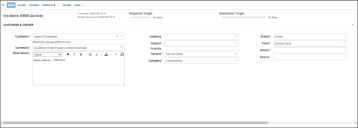Go to Record Quick Action (GAD)
•About the Go to Record Quick Action
•Classic Action Designer: Go to Record Quick Action (CAD)
About the Go to Record Quick Action
To use this Quick Action, set the global constant EnableActionService to True.
The Go to Record action allows ITSM to switch context between records in a business object based on input criteria. Subsequent actions can then be performed on the destination record.
The input criteria can come from a webhook, from another action, or from the field value of the current record This action can be used standalone or with other actions.
There is an option for the action to create a new record if not found without it throwing an error or the user having to make amendments.

Suggestions for Use
Here are a few ways you can use the Go To Record action:
•Updating a field on an Incident: Going to a related Incident, for example, a parent/master incident, and updating more fields there, without the use of the Run for Child action.
•Navigating to records outside of UI contexts: For example, when you send data to a webhook the system has no way of knowing which record to run against because you aren’t selecting anything in the UI. This allows you to use webhooks for scenarios beyond simple record creation; for example, you could specify a value within the webhook data that contains the unique identifier for an existing record, then use the Go to Record action to actually navigate to that record and update it.
•Using with the Run for Collection action: Specify a JSON or XML collection of records to update, where each entry has a unique identifier for a different record. Use the Run for Collection action and the Go to Record action together to iterate over the collection, go to the record for each item in the collection, and perform some action on the record before proceeding to the next.
•Creating actions with more complex logic than has been possible in the past: The most common example of this is “I want to update a record if it exists, or create it if it doesn’t”. You can easily use the Go to Record action to navigate to an existing record, but also use the Create Record if not Found option to create the record if it doesn’t exist. A real-world example is that of a customer using the CI business object and an external system which sends data about these CI records to ITSM. Using the Go to Record action. incoming CI data can be used to update existing records, but if the external system finds some new CI and sends that as part of the data, the Create Record if not Found option automatically creates a record in ITSM for the new item.
Parameters
To access the parameters select the Action Block to display them in the Settings pane.
Action Block Settings
Block Label: A unique name for the block. This is useful to identify each action when you have more than one of the same action block added or cloned in the design area.
| Field | Parameter |
|---|---|
| Business object |
The business object to use with this action. The fields that appear are based on the business object. At present, your choice of business object is fixed so you can only use the current business object associated with the Go To Record action. Hence you can only go to records for that one business object. |
| Field Name | The field name that is used as part of the input criteria for finding the record to go to. Only unique field names are included in the drop-down list. |
| Field Value | The value that is used as as part of the input criteria for finding the record to go to. There must be only one record with this value as multiple records cannot be used when using Go To Record. |
| Create a new record if not found |
When switching records, if a record cannot be found that fulfils the input criteria, select this option to create a new one automatically. When this option is selected, new fields appear below this option for you to add values for populating the new record. When the new record is created, the field values you previously entered for all the required and unique fields are auto-populated and the record is validated. It will look something like this: If you select the option for Create a new Record if not found but don't enter any values, you get an error message saying that field data is missing. |
|
Add Field |
Adds another field to be used when populating fields in the new record. |
Click Save to commit your changes.
Start Block Settings
These settings are accessed by selecting the Start Block, see Start Block Settings.
